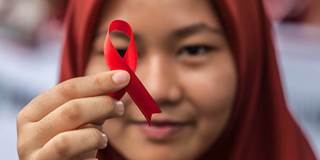Despite decades of progress, HIV infection rates are highest among those who live on the margins of society, underscoring the importance of linking public-health battles with human development. That is why the fight against HIV will not end until the Sustainable Development Goals are met.
BRIGHTON – Thirty years ago, when the international community marked the first World AIDS Day, we thought we would never turn the tide against HIV. But after millions of deaths and years of fear, we now have effective strategies to prevent transmission and bring testing and treatment to those in need.
And yet, despite the remarkable progress made during the last three decades – or perhaps because of it – we must avoid the temptation to declare the fight against AIDS almost over. In many parts of the world, the hardest work is just beginning.
Since the turn of the century, many of the advances against HIV were enabled by the Millennium Development Goals (MDGs), a 15-year policy roadmap that made reducing the spread of the virus a top priority. This led to an unprecedented expansion of prevention and treatment services, particularly in developing countries. Progress was swift and when the Sustainable Development Goals (SDGs) succeeded the MDGs in 2015, ending AIDS was no longer a standalone goal. Rather, further progress had become one of 169 targets that the SDGs are supposed to achieve by 2030.

BRIGHTON – Thirty years ago, when the international community marked the first World AIDS Day, we thought we would never turn the tide against HIV. But after millions of deaths and years of fear, we now have effective strategies to prevent transmission and bring testing and treatment to those in need.
And yet, despite the remarkable progress made during the last three decades – or perhaps because of it – we must avoid the temptation to declare the fight against AIDS almost over. In many parts of the world, the hardest work is just beginning.
Since the turn of the century, many of the advances against HIV were enabled by the Millennium Development Goals (MDGs), a 15-year policy roadmap that made reducing the spread of the virus a top priority. This led to an unprecedented expansion of prevention and treatment services, particularly in developing countries. Progress was swift and when the Sustainable Development Goals (SDGs) succeeded the MDGs in 2015, ending AIDS was no longer a standalone goal. Rather, further progress had become one of 169 targets that the SDGs are supposed to achieve by 2030.